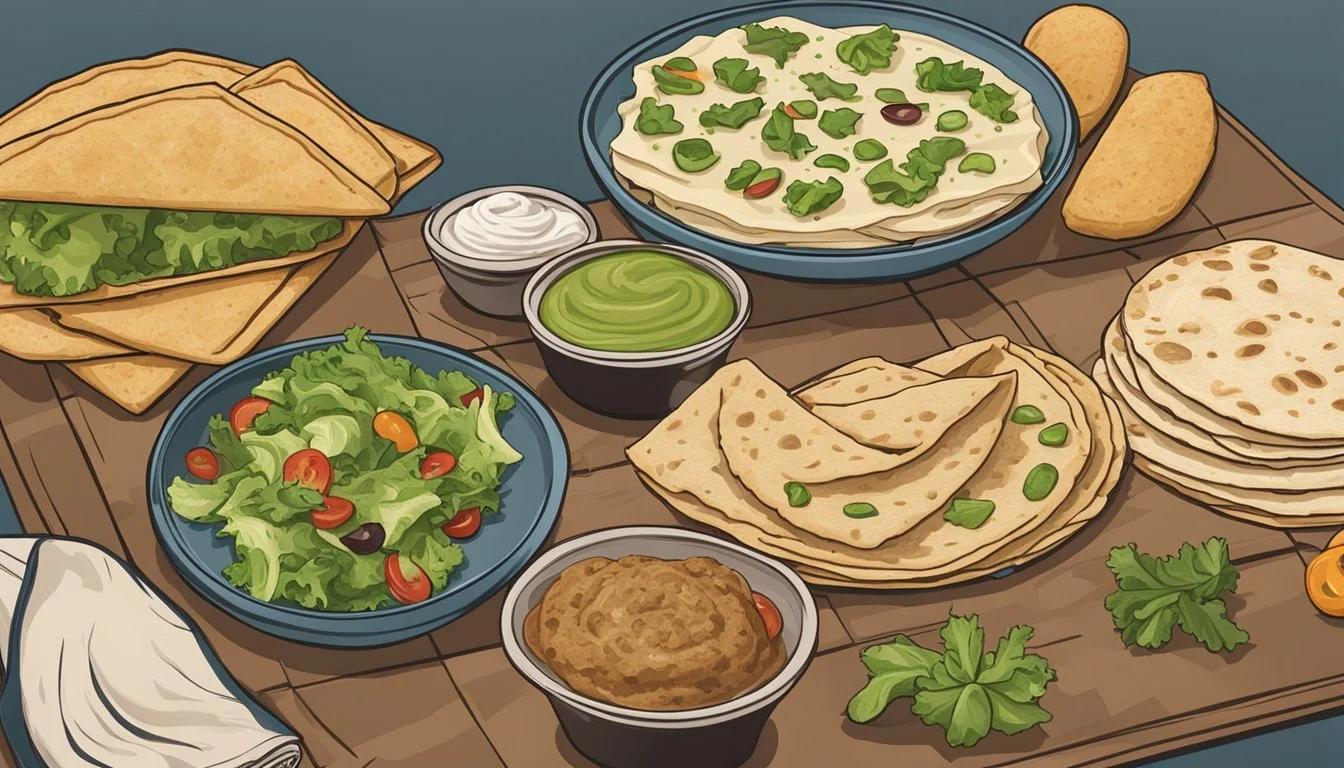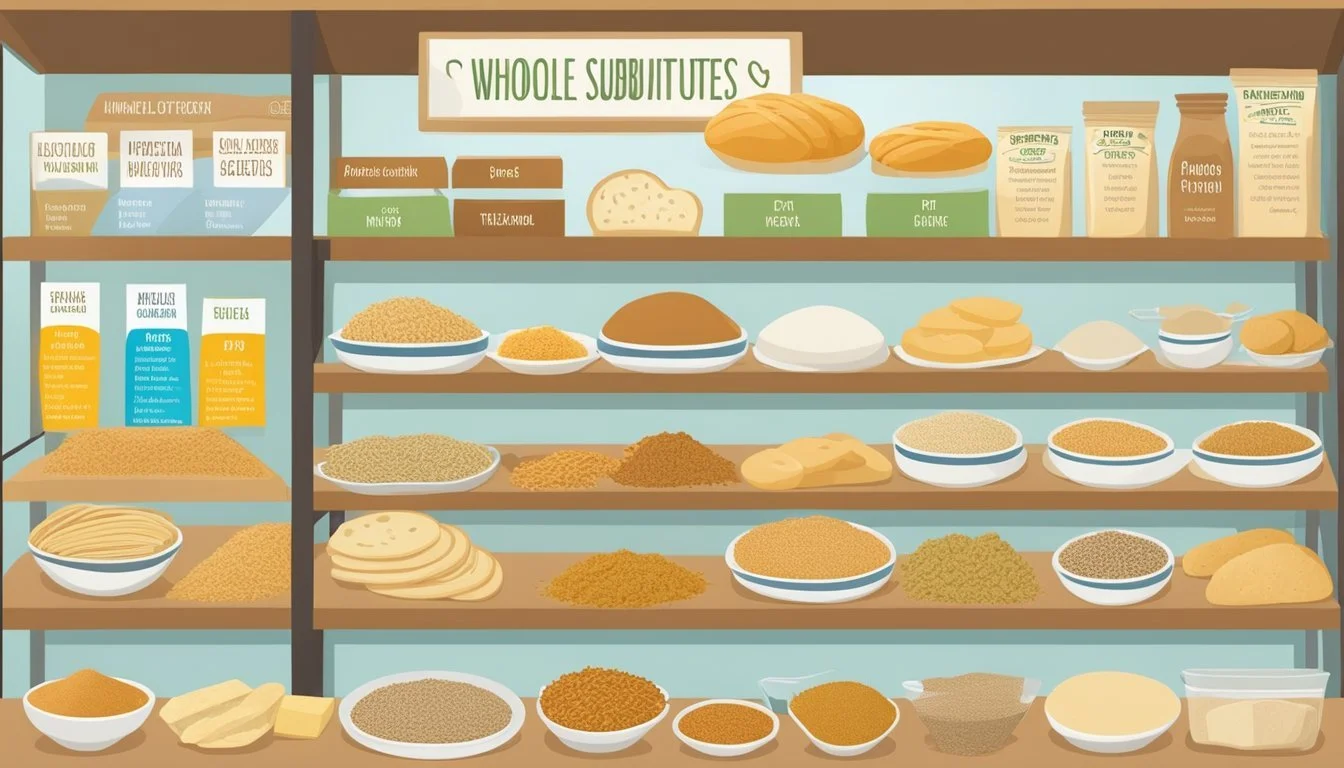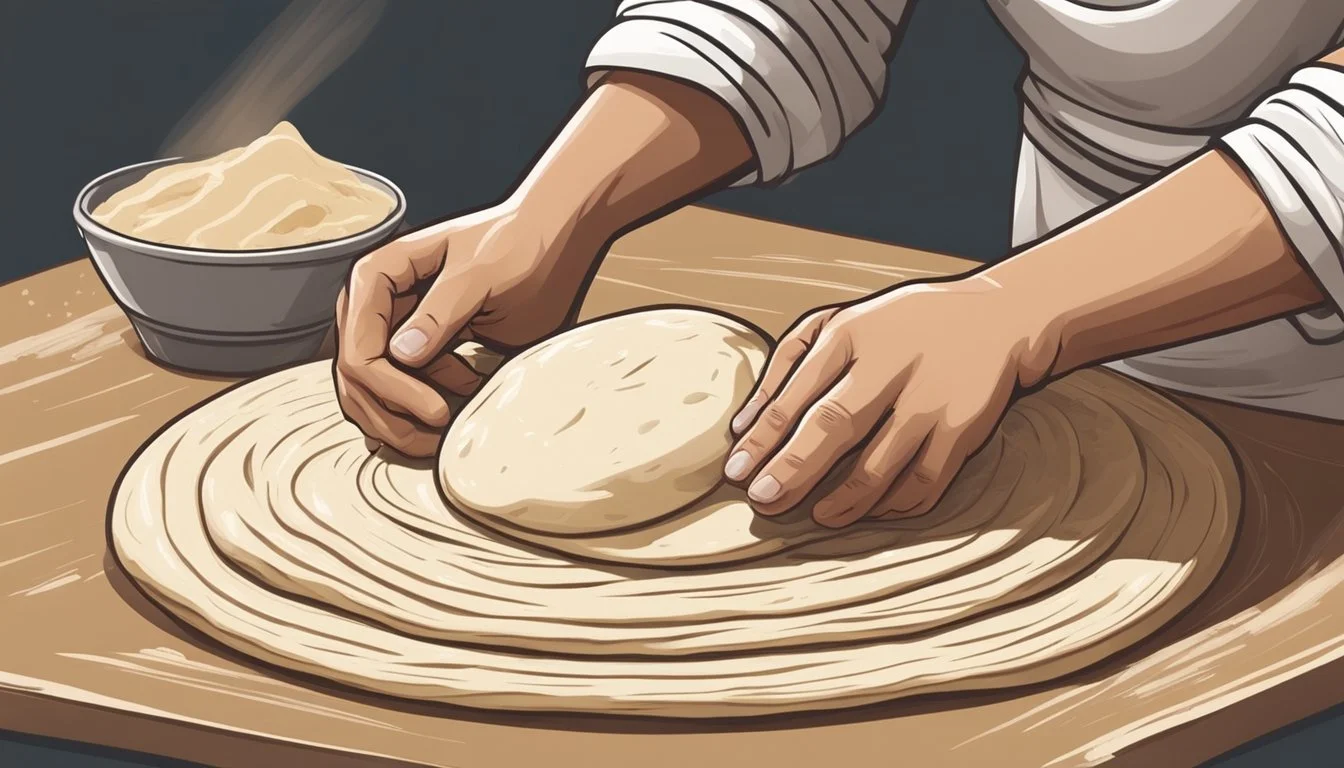Pita Bread Substitutes
Top Alternatives for Your Meals
Pita bread, a staple of many cultural cuisines, is a round pocket bread widely enjoyed for its versatility. It serves as an essential component for a variety of dishes, ranging from sandwiches to dips. However, those following low-carbohydrate or gluten-free diets may often seek alternatives that align with their dietary preferences. With the increasing demand for such options, a variety of pita bread substitutes have emerged, offering health-conscious consumers the ability to enjoy their favorite meals without compromising on their nutritional needs.
Substitutes range from vegetable-based options to protein-rich creations. Lettuce wraps have become a popular choice for their crisp texture and low carbohydrate content, making them an excellent vehicle for fillings traditionally housed by pita bread. Similarly, cloud bread, an innovative low-carb alternative made primarily from eggs and cream cheese, provides a soft, bread-like texture suitable for those on ketogenic diets. These alternatives not only cater to dietary restrictions but also add a new dimension of flavor and texture to familiar dishes.
Understanding Pita Bread
Pita bread is a staple in many Middle Eastern and Mediterranean cuisines. This versatile flatbread is characterized by its soft texture and a pocket that forms due to steam puffs during the baking process.
Ingredients of Pita Bread: Pita typically consists of basic ingredients such as:
Flour: Whole wheat or white, contributing to the gluten content that gives the bread its structure.
Water: Essential for dough formation.
Salt: Adds flavor and regulates yeast activity.
Yeast: A leavening agent that helps the dough rise.
The leavening process involving yeast is crucial for creating the iconic pocket within the pita. After kneading, the dough is usually allowed to rest until it doubles in size, which contributes to a better-textured bread.
Nutritional Content:
Gluten: Present in pita made with traditional wheat flour, it's important for people with gluten sensitivities to be aware.
Fiber: Whole wheat pita contains more fiber than its white flour counterpart.
Protein: There is a modest amount of protein in pita bread.
Variations:
Pita can be made with different types of flour including all-purpose, whole wheat, or even gluten-free blends for those with dietary restrictions.
Different additions like seeds or herbs can provide unique flavors and texture.
Pita is typically baked in a hot oven, which results in its distinctive puff. Once removed from the oven, the layers of the bread deflate, leaving a pocket that's perfect for fillings. This bread is not only a part of daily meals but also serves as a utensil for scooping or holding various foods.
Nutritional Profile of Pita Bread
Pita bread, a staple in Mediterranean and Middle Eastern cuisines, offers a unique nutritional profile that contributes to its popularity. This flatbread is generally composed of the following constituents:
Calories: A typical serving of pita bread contains about 165 calories, making it a moderate-calorie choice for meals.
Carbohydrates: It has approximately 33.5 grams of carbohydrates per serving, which provides energy for daily activities.
Protein: Each pita provides around 5.5 grams of protein, contributing to muscle maintenance and growth.
Fiber: With about 1 gram of fiber, whole grain varieties of pita bread contain more due to the higher content of bran.
Sugar: Pita contains a minimal amount of sugar, usually less than 1 gram per serving.
Nutrients: It is a source of certain micronutrients, including small amounts of calcium, magnesium, and potassium.
For those considering the health benefits of pita bread, choosing whole grain versions is recommended, as they contain more fiber and nutrients compared to white pita bread. Moreover, whole grain pita bread supports a healthier digestive system and provides a more sustained energy release.
In terms of sodium content, pita can have about 120 milligrams per serving, or 5% of the recommended daily allowance. Those watching their salt intake might need to take this into consideration.
For individuals who have iron deficiency, pita bread serves as a source of iron, essential for the formation of hemoglobin in red blood cells. It contains approximately 1.08 milligrams of iron per serving, contributing to 6% of the recommended daily allowance.
Overall, pita bread can be a nutritious part of a balanced diet, particularly when choosing whole grain options and considering portion sizes.
Pita Bread in Dietary Considerations
When incorporating pita bread into one’s diet, it's imperative to consider various dietary needs and restrictions. Pita bread typically contains gluten, a group of proteins found in wheat, which can be problematic for those with gluten sensitivity or celiac disease. Individuals with these conditions require gluten-free substitutes to avoid adverse health effects.
For those following a low-carb diet or a keto diet, traditional pita bread made from wheat flour may not align with their dietary goals due to its carbohydrate content. It is essential to look for low-carb or keto-friendly alternatives that have reduced net carbs.
Diet Type Consideration for Pita Bread Gluten-Free Avoid regular pita; opt for gluten-free alternatives. Low-Carb/Keto Seek products with lower net carbs. Diabetic-Friendly Monitor glycemic index; choose whole grain when possible.
For those focused on a diabetic-friendly diet, the glycemic index of the bread is a key factor. Whole grain pita bread may be a preferable option, as it tends to have a higher fiber content compared to its white flour counterparts, which can help regulate blood sugar levels.
In summary, while pita bread can be a nutritious part of many diets, attention must be paid to its composition and how it aligns with individual dietary requirements. Considering alternative preparations made with whole grain or specialized formulations to suit gluten-free and low-carb preferences is important for maintaining a balanced and inclusive meal plan.
Pita Bread Making Basics
Making homemade pita bread involves combining key ingredients, employing specific baking techniques, and utilizing proper storage methods to maintain freshness. This section outlines the essentials every baker should know for crafting this versatile bread.
Ingredients and Preparations
The foundation of pita bread begins with simple ingredients: all-purpose flour or whole wheat flour, water, salt, sugar, and yeast. Occasionally, some recipes may call for baking powder.
Flour: All-purpose flour yields light and fluffy pitas, while whole wheat flour adds a nuttier flavor and denser texture.
Water: Lukewarm water activates the yeast, aiding in dough rise.
Salt: Enhances flavor and regulates yeast activity.
Yeast: Active dry yeast or instant yeast can be used to leaven the bread.
Sugar: A small amount helps to activate the yeast more quickly.
Preparation Steps:
Dissolve the sugar in warm water and sprinkle yeast on top, allowing it to activate.
Mix flour and salt, then incorporate the yeast mixture.
Knead the dough until smooth, cover, and let it rise until doubled in size.
Divide the dough and shape into small balls.
Baking Techniques
Pita bread can be baked in an oven or cooked on a hot skillet.
Oven Baking:
Preheat the oven to a high temperature, usually around 450°F (230°C).
Roll out the dough balls to an even thickness.
Bake on the lowest oven rack on a preheated baking stone or sheet pan until they puff up.
Skillet Cooking:
Heat a heavy, cast-iron skillet to a medium-high temperature.
Cook rolled-out dough until it puffs and achieves golden brown spots, then flip.
Tips for Baking:
Ensure the oven is thoroughly preheated for an even puff.
Avoid overcrowding the pita to allow for full expansion.
Rolled dough should be neither too thin nor too thick to ensure proper puffing.
Storing and Reheating
Storing Fresh Pita:
Once cooled, store in an airtight container to keep them soft and pliable.
Pita bread can be kept at room temperature for a couple of days or in the freezer for longer storage.
Reheating Instructions:
In a hot skillet for a few seconds on each side until warm.
Alternatively, wrap pitas in foil and warm in an oven.
Pita can be prepped ahead and stored in the refrigerator before the final shaping and baking or cooking. This can enhance the flavor and make the bread-making process more convenient.
Common Pita Bread Alternatives
Pita bread, a versatile staple in many diets, can be substituted with various options catering to gluten-free, low-carb, and other dietary preferences.
Gluten-Free Choices
For individuals dealing with gluten sensitivity or celiac disease, gluten-free alternatives are essential. Gluten-free flour blends made with ingredients such as rice flour, potato starch, or cornstarch provide the base for substitutes. One can choose gluten-free tortillas or opt for gluten-free pita-style bread crafted from corn and oats, ensuring no gluten-containing grains are involved.
Low-Carb and Keto Options
Those following a keto diet or requiring low-carb bread products often turn to almond flour or coconut flour as they are naturally low in carbohydrates. Possible substitutes include:
Cloud Bread: Made with eggs and cream cheese, resembling pita in texture.
Lettuce Wraps: Using large iceberg lettuce leaves for a fresh alternative.
Nori Sheets: Seaweed sheets that can wrap ingredients similar to a sandwich.
Other Bread Substitutes
Besides gluten-free and keto-friendly options, there are other bread substitutes available. They include:
Corn Tortillas: A suitable choice, providing the flexibility and utility similar to pita bread.
Rice Paper: Typically used in Asian cuisine, these can wrap fillings neatly.
These substitutes offer flexibility and variety to those seeking alternatives to traditional pita bread, ensuring dietary needs and personal preferences are met.
Creating Dishes with Pita Substitutes
Exploring pita substitutes offers a fresh approach to familiar dishes. One can maintain the often sought-after healthy and easy-to-make attributes that pita bread provides by selecting appropriate alternatives.
Sandwich and Wrap Ideas
Bean and Cheese Tortilla Wrap:
Beans: A protein-rich alternative filling, to maintain taste and satiety.
Cheese: Adds a creamy texture, with feta cheese as a popular choice.
Lettuce/Cucumber: For crunch and freshness, adding a hydrating element.
Wrap: Large lettuce leaves or tortillas can substitute for pita, wrapping contents snugly.
Grilled Veggie Pockets:
Veggies: Grilled eggplant and carrots offer a smoky flavor and tender texture.
Hummus: Acts as a spread and flavor enhancer, bringing creaminess and rich taste.
Pocket: Flatbread or folded naan bread provides a comparable pocket experience.
Salads and Sides
Crispy Salad Croutons:
Pita Substitute: Whole grain crackers or toasted bread pieces add crunch.
Mix-ins: Fresh diced veggies such as cucumbers and carrots combined with cheese crumbles.
Dressing: A light vinaigrette or Greek dressing complements without overpowering.
Mediterranean Salad Plate:
Base: A bed of crisp lettuce and an array of veggies offer fresh, diverse textures.
Protein: Cubed cheese, especially feta, and hummus contribute to the Mediterranean profile.
Sides: Small servings of eggplant dip or carrot salad can be added around the plate.
These selections ensure that the transition from pita bread to other substitutes can be done smoothly, without compromising on health, ease, or flavor.
Homemade Pita Substitutes
When crafting a pita substitute at home, one should consider the simplicity of the recipes and the cooking techniques. A proper approach involves readily available ingredients and common kitchen tools such as a rolling pin and skillet.
Simple Recipes
For a straightforward pita substitute, one can harness the versatility of leafy greens. Here's a quick method:
Leafy Green Wraps: Use large, soft lettuce leaves like Bibb or butter lettuce. For more resilience, one might double up the leaves.
Alternatively, for those seeking a more bread-like substitute:
Ingredients:
Flour
Warm water or milk
Yeast or baking soda
Salt
Sweetener (optional, for yeast activation)
Oil or butter
A basic dough can be formed with these ingredients; experienced individuals often opt for baking soda if yeast is not available.
Cooking Techniques
Skillet Method:
Flatten portions of the dough with a rolling pin.
Cook each flattened piece in a hot skillet, flipping once, until puffed and browned.
Baking Method:
Preheat oven.
Roll out portions of dough.
Place on a baking tray lined with parchment paper.
Bake until puffed up and golden.
By using a rolling pin and a hot skillet or an oven, one can achieve a homemade substitute that emulates the qualities of pita bread. It's easy to make and offers flexibility in terms of ingredients and cooking methods.
Health Benefits of Pita Substitutes
Substituting pita bread with alternatives can offer a nutritional advantage by diversifying the intake of healthy nutrients, including protein, fiber, and complex carbohydrates. These can contribute to improved blood sugar management, enhanced digestive health, and a better macronutrient balance.
Macronutrient Balance
Alternatives to traditional pita bread, particularly those made with whole grains, legumes, or sprouted grains, can provide a more balanced profile of macronutrients. Whole-grain substitutes are rich in complex carbohydrates, which aid in sustained energy release. They may also offer a higher protein content, especially if they include protein-rich ingredients such as legumes. This balanced combination of nutrients supports muscle function and repairs tissue.
Blood Sugar Management
For individuals monitoring their blood sugar, such as those with diabetes, choosing substitutes with a low glycemic index is beneficial. Whole-wheat pita alternatives and products made from legumes tend to have a lower glycemic index compared to white flour-based pita bread. This helps in avoiding sharp spikes in blood sugar levels, making these options more diabetic-friendly and conducive to long-term health management.
Digestive Health
Fiber is a pivotal nutrient for digestive health, and pita substitutes often contain higher amounts than traditional white flour pita bread. Options such as pita made from whole grains or those that incorporate sprouted grains contribute to a healthy digestive system by ensuring regular bowel movements and preventing constipation. The inclusion of fiber in a diet also supports a healthy gut microbiome, crucial for overall well-being.
Selecting pita bread substitutes that emphasize these properties can lead to improved health outcomes and support a diverse and nutritious diet.
Shopping for Pita Bread and Substitutes
When considering pita bread and its substitutes, shoppers should focus on the availability in stores, the ingredient quality found in bakeries, and the health aspects of store-bought options.
Store-Bought Options
In the aisles of grocery stores, one can find a variety of pita breads and alternatives. Pita breads usually come in whole grain and white flour versions; whole grain being a healthier choice due to its higher fiber content. For alternatives, shoppers may look for flatbreads or other wrap options, which may include items like lavash or tortillas. A careful inspection of labels is crucial; it’s beneficial to opt for products with minimal added sugar and preservatives. Here are key points to consider:
Ingredients: Seek out whole grain or sprouted grain options for added nutritional benefits.
Variety: Explore flatbreads or lettuce wraps as low-carb substitutes for traditional pita bread.
What to Look for in Bakeries
When visiting a bakery, the freshness of pita bread can greatly surpass that found in a store. Bakeries might offer a variety of pita breads, including those made from whole grain or sprouted grains. Customers should look for:
Freshness: Freshly made pita breads often have a softer texture and a more pronounced flavor.
Ingredient Quality: Artisan bakeries might use higher-quality ingredients with fewer additives compared to commercial store-bought pitas.





